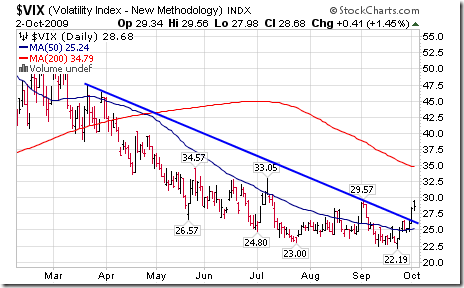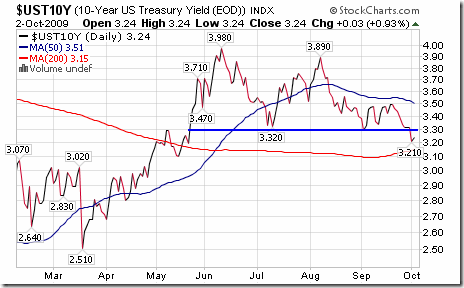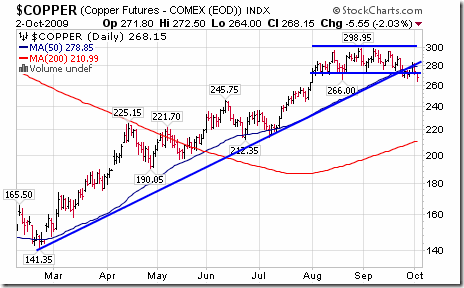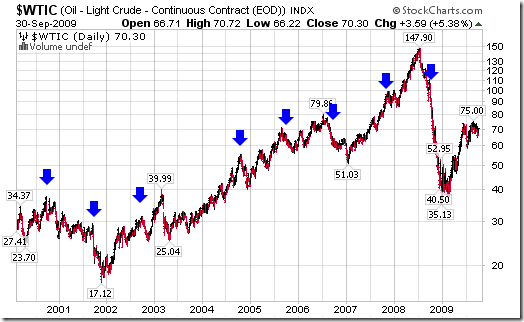
Ed Note: Strongly recommend you go to Don’s site and look at the 40 plus charts and analysis….. six of those charts below. PLUS an excellent article written by Don on OIL.
The Bottom Line
Trading strategies remain the same. Equity indices and ETFs are not compelling purchases at current prices. The 6% decline by major equity indices since their highs set on or about September 23rd is a good start on the current correction, but more is yet to come. Average decline by the S&P 500 Index following a major recovery is 12.2%. In other words, the bottom of the current correction now is significantly closer than previous. Investors sitting on the sidelines are using their valuable time to research possible seasonal buying opportunities when the current correction is over. Tech Talk is doing homework on several sectors including technology and transportation. Stay tuned.
Seasonal influences on U.S. equity markets tend to be weak in October in the year after a U.S. president is elected.

The VIX Indicator rose 3.07 (12%) last week. All the gains were recorded on Thursday and Friday. Its intermediate downtrend line was broken. Resistance at 29.57% is being tested. Concerns are rising that the economic recovery has stalled.

The yield on 10 year U.S. Treasuries slipped last week from 3.34% to 3.24% and broke support at 3.32%. Intermediate trend now is down.

Copper remains under technical pressure. Copper lost another $0.06 per lb. last week. Intermediate trend is down. Short term momentum indicators (MACD, RSI and Stochastics) continue to trend lower from overbought levels.

Gold added $12.10 U.S. per ounce last week. Resistance is forming at $1,024.20. Short term momentum indicators currently are mixed. Investors, that entered the seasonal trade from July 12th to October 9th suggested in Thackray’s 2009 Investor’s Guide, are looking for an exit. This year, the seasonal trade based on Stochastics recorded a buy signal on July 10th at $907.30. Technicals for the exit have yet to appear. Intermediate downside risk is to its 200 day moving average currently at $928.70.

Tech Talk’s Weekly Column in the Financial Post
Crude awakenings for investors playing the energy sector in October and November
Crude oil and refined petroleum products have entered the October and November “shoulder season” between the summer driving/air conditioning period and the winter heating period. Demand is lower than average in October and November. History shows that crude oil, energy equity indices and energy equities tend to move lower during this period. What are expectations this year?
Seasonal influences
Crude oil prices have declined in eight of the past 10 October/ November periods for an average loss of 9.8% per period. Lower crude oil prices have impacted energy equity indices on both sides of the border. The S&P Energy Index has declined in six of the past 10 periods for an average loss per period of 3.4 percent. The TSX Energy Index has moved lower in seven of the past 10 periods for an average loss per period of 7.8 percent. The Philadelphia Oil Service Index dropped in seven of the past 10 periods for an average loss of 10.1 percent per period.
Fundamental influences
Lower demand during the shoulder season is one of several reasons why crude oil and energy equity indices are likely to come under pressure this year. World crude oil inventories are near an all time high. Oil storage now includes large ships filled with oil anchored offshore. Heating oil inventories in the U.S. are at a 27 year high. Gasoline inventories recorded a surprising decline last week, but remain above the upper limit of the five year average range. Another factor this year is a recovery by the U.S. trade weighted dollar from an oversold level. Crude oil prices have a high negative correlation with the U.S. Dollar.
Technical influences
Crude oil and energy equity indices have deteriorating technical profiles. Crude oil peaked on August 25th at $75.00 U.S. per barrel. It recently established an intermediate downtrend. Short term momentum indicators (Moving Average Convergence Divergence, Relative Strength Index and Stochastics) have rolled over and are trending lower. Intermediate downside risk until the end of November is to support indicated at $58.72. Energy equity indices including the S&P Energy Index, the TSX Energy Index and the Philadelphia Oil Service Index peaked on or about September 17th. All recorded short term momentum sell signals last week.
What to do?
Preferred strategy is to defer additional crude oil and energy equity purchases until near the end of November. Investors currently owning energy investments can protect their holdings at least partially by selling at-the-money call options against existing positions.
Historically, the period of seasonal weakness in crude oil and energy equity Exchange Traded Funds has set the stage for a period of seasonal strength. Bottoming patterns on the charts usually form in December and early January. A period of seasonal strength normally appears in mid January.

Editor Note: Highly recommend that you take a monday morning visit to this Don Vailoux monday report where he analyses an astonishing 40 plus Stocks, Commodities and Indexes.
Don Vialoux has 37 years of experience in the Investment Industry. He is a past president of the Canadian Society of Technical Analysts (www.csta.org) and a former technical analyst at RBC Investments. Now he is the author of a daily letter on equity markets available free on the internet. The reports can be accessed daily right here at www.dvtechtalk.com.
Impossible! That’s what institutional investors say about “Timing the Market”. Mr. Vialoux will explain that, indeed, it can be done with the appropriate analysis. He also will explain why timing the market will be important during the next decade. Buy and Hold strategies are not working anymore; Investors are looking for alternatives. Mr. Vialoux will demonstrate four techniques that can be used to time intermediate stock market swings lasting 5-15 months. The preferred investment vehicles for investing in intermediate stock market swings are Exchange Traded Funds.
Comments in Tech Talk reports are the opinion of Mr. Vialoux. They are based on technical, fundamental and/or seasonal data that is believed to be accurate. The comments are free. Mr. Vialoux receives no remuneration from any source for these services. Comments should not be considered as advice to buy or to sell a security. Investors, who respond to comments in Tech Talk, are financially responsible for their own transactions.
